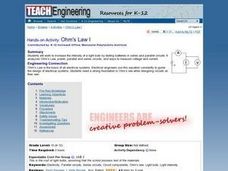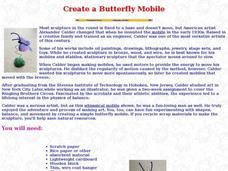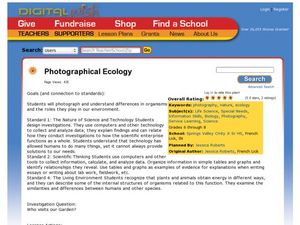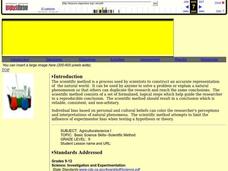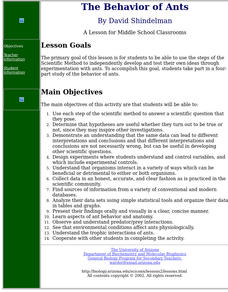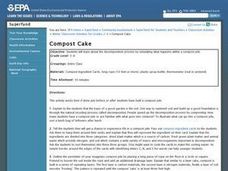Curated OER
Biology - Virus Modeling
Students research one of the many types of viruses. They create a 3-D model of the virus they researched with graphics software.
Curated OER
Bioethics: Debates in Human Genetics
Young scholars, in groups, research and prepare a debate regarding various bioethical situations. After the debates, each student prepares a ortfolio outlining their own personal opinions.
Curated OER
Ohm's Law I
Students work to increase the intensity of a light bulb by testing batteries in series and parallel circuits. They analyze Ohm's Law, power, parallel and series circuits, and ways to measure voltage and current.
Curated OER
It's Really Heating Up in Here!
Students create and observe a greenhouse effect model and discuss the implications of global warming theory for engineers, themselves and the Earth. They discover that Global warming is becoming an increasing concern as we learn more...
Curated OER
Electron Transport System Made Fun and Easy:
High schoolers identity the components of electron transport system through role play. They explain the role of intermediate energy carriers to the production of ATP molecules. They describe the relationship of electron transport system...
Curated OER
Primary and Secondary Colors Mixing Activity
Students explore color recognition through mixing the primary and secondary colors together. They color in an online rainbow using primary and secondary colors, identify the colors on a color mixing poster, then mix the colors using...
Curated OER
Create a Butterfly Mobile
Students construct a butterfly mobile. In this visual arts lesson, students use rice paper, watercolors, a coat hanger, and wax paper to create a unique butterfly mobile. Students use photographs of butterflies to construct a realistic...
Curated OER
People Change the Landscape
Students examine ways in which humans have brought change to the natural environment. In this ecology and literacy instructional activity, students listen to the book Island Boy by Barbara Cooney. Students observe and define map-reading...
Curated OER
Swings
Young scholars investigate variables which may seem to affect the movement of a pendulum, or "swing."They interpret their observations and apply the scientific principles to develop explanations and solve a new problem.
Curated OER
Plant Growth
Third graders keep a journal and record the growth of their plant everyday over a two week period. With an observation written down for everyday of the week, they draw a picture of their plant in their journal on Monday and Friday...
Curated OER
What Does it Take to be a Survivor? Part One
Students explore marine animal adaptation. In this introductory ocean life biology lesson, students access prior knowledge by participating in a whole class "thought swap." Students form two lines, respond to a prompt from the teacher...
Curated OER
Biomes
Students collect information about different biomes, and locate the biomes on a world map. They read a climograph and match them to the appropriate biomes.
Curated OER
STRAINING FOR SOUND
Sixth graders use a laser along with computer microphone probeware and the appropriate software, 6th graders determine the speed of rotating objects.An audio amplifier is connected to a solar cell to change the laser light signal into a...
Curated OER
Pigs, Pigs, Pigs!
Third graders find information about different breeds of pigs using the Internet, books, and encyclopedias. Groups select one breed of pig that interests them. They construct a stuffed likeness of the pig.
Curated OER
3RC (Reduce, Reuse, Recycle and Compost)
Learners examine the effects of packaging decisions and the engineering advancements in packaging materials and waste management. They observe biodegradation in a model landfill.
Curated OER
Acid Stomach
Students develop an understanding of how aspirin works and how understanding it's interaction with other chemicals in the body aided doctors in medical research. They complete a lab that compares the reaction of regular aspirin and...
Curated OER
Barnegat Bay Watershed
Students design a model watershed. For this watershed lesson, students learn the needed parts of a watershed and how they work. Students evaluate how watersheds effect communities.
Curated OER
Photographical Ecology
Learners study organisms and the roles they play in nature. In this ecology lesson, students photograph several examples of organisms during a nature walk. Learners print out their photos and classify the organisms as plants or animals.
Curated OER
Who's Afraid of the Big, Bad Wolf?
Students compare wolves' behaviors to those of the human race. In this wolf lesson students write a story that will show that wolves are either good or evil.
Curated OER
Scientific Method
Young scholars explore how to use the scientific method to solve problems. In this scientific lesson students define terms, apply the method to problems and search the internet and find sites that cover the scientific method.
Curated OER
The Identification of Bacteria
Students are given a two week period to put to use the knowledge they have gained while studying bacteria. As a culminating activity, students each receive three unknown bacteria to identify.
Curated OER
The Behavior of Ants
Students use the steps of the Scientific Method to develop and test their own ideas through experimentation with ants.
Curated OER
Introduction to Classification
Fourth graders design a classification system to categorize animate and inanimate objects. They discuss the advantages of grouping things as they classify buttons, leaves, shells.
Curated OER
Compost Cake
Students examine the decomposition process. They create their own class compost pile and record their observations. They discover which materials decompose at a different rate.


